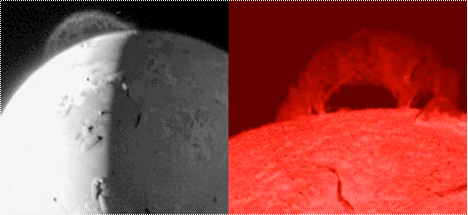
Left: Tvashtar “volcanic plume” on Io. Credit: NASA/New Horizons mission.
Right: Solar prominence. Credit: NASA/Marshall Spaceflight Center.
Nov 07, 2012
Phenomena throughout the visible universe exhibit features that are twisted and “stringy”. From plume to prominence it is plasma interactions that we see.
In previous Picture of the Day articles, there have been many discussions about formations cut in stone or puffed-out in clouds of ionized gas that are not easily explained by conventional theories. Two such figures are shown at the top of the page. One is said to be a volcano erupting on the surface of Jupiter’s active moon Io. The other is a massive flaring eruption from the Sun. How do both events relate to one another when they occur in such disparate environments?
Every world in the solar system is a charged body orbiting in a plasma. There are many ways in which plasma interacts with dust or atmospheric gasses no matter how hot or cold they are. Spacecraft sent to other planets, as well as satellites orbiting our own planet, have detected auroras, lightning, tornadoes and dust devils. Volcanoes on Earth have been found to “spit lightning” from their vents. Global dust storms on Mars are shown to be fed by thousands of sky-high funnels. Farther into the Solar System remote instruments are finding radio noise, electrified comets, spokes in Saturn’s rings and many other modes of electrical activity.
When plasma moves through a dust or gas, it tends to ionize the material and cause electric current to flow. As was demonstrated by Faraday more than a century ago, when electricity pushes through any substance a magnetic field is created. One aspect of magnetism in electrified plasma is that it creates what are sometimes called “plasma ropes”. The magnetic field surrounds the plasma, confining it into a coherent system known as a Birkeland current.
Birkeland currents are twisted current filament pairs that transport charge great distances through space following the ambient magnetic field in “force-free” mode.
The Sun’s energy moves through the solar system in Birkeland currents for billions of miles as the solar wind – a name that is, unfortunately, inadequate in its strictly mechanical definition. In reality, there is a storm of ions accelerating out of the Sun along gigantic filaments.
Electric Universe theorists insist that galactic evolution can also be explained in terms of large-scale plasma discharges that form spirals of coherent filaments. Why stars in galaxies tend to coalesce in long arcs like bright beads on a line is one of a hundred mysteries that conventional cosmology must confront. No gravity-only hypothesis can resolve the issue of star formation, in general, but the structure that has been seen within the barred spirals and the tremendous elliptical whirlpools that congregate in million-light-year clusters continues to elude explanation.
As Don Scott, author of The Electric Sky and from whom the title of this paper was stolen, wrote about the way plasma acts in the Universe:
“Plasma phenomena are scalable. Their electrical and physical properties remain the same, independent of the size of the plasma. In a laboratory plasma, of course, things happen much more quickly than on, say, galaxy scales, but the phenomena are identical — they obey the same laws of physics. In other words we can make accurate models of cosmic scale plasma behavior in the lab, and generate effects that mimic those observed in space. It has been demonstrated that plasma phenomena can be scaled to fourteen orders of magnitude. (Alfven hypothesized that they can be scaled to 28 orders or more!) Electric currents flowing in plasmas produce most of the observed astronomical phenomena that remain inexplicable if we assume gravity and magnetism to be the only forces at work.”
Stephen Smith












